
Saints for a New Year
We honor the saints because they followed the way of Jesus, each in their own way and with their own gifts and talents. The saints encourage us to follow Jesus, to love God and others, using our own gifts and talents, just as they did. These five saints each have something to teach us about following Jesus. What might that be? Let’s find out!
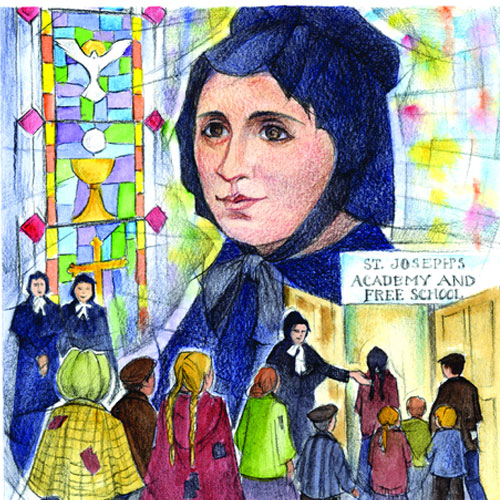
Saint Elizabeth Ann Seton (1774-1821)
Feast day, January 4
Saint Elizabeth Ann Seton grew up in New York City, just after our country gained its independence from England. She was brought up in the Church of England, and went to Trinity Church. The third church building (built in 1846) stands at Broadway and Wall Street in New York City. With her stepmother, Elizabeth belonged to a women’s group that visited the poor and helped provide them with food and clothing.
Elizabeth married William Seton, a successful businessman, and had five children. (They lived at 8 State Street, near the waterfront, where the Church of Our Lady of the Rosary, part of the shrine to Saint Elizabeth Seton, now stands.) When her husband fell ill, Elizabeth went with him to Italy, thinking the sunnier climate would help him. Sadly, he died soon after their arrival.
While staying with friends in Italy, Elizabeth went to Mass and learned that Jesus was really and truly present in the Eucharist. When she returned home, she learned more about the Catholic faith. Eventually she was baptized in the original St. Peter’s Church in New York City, built in 1785. The replacement, built in 1834, is near One World Trade Center, the new tower that is now the tallest building in the United States.
After Elizabeth became a Catholic, many of her old friends showed their disapproval and stopped speaking with her. She also had no way to support her children. When the priest of St. Mary’s Seminary in Baltimore invited her to start a school there, she accepted. Eventually some young women joined her, and they formed the Sisters of Charity, a religious community dedicated to education and to helping those who were poor or sick. Elizabeth then became known as Mother Seton.
Saint Elizabeth Seton is the first native-born American saint and is recognized for beginning the Catholic School system in the United States.
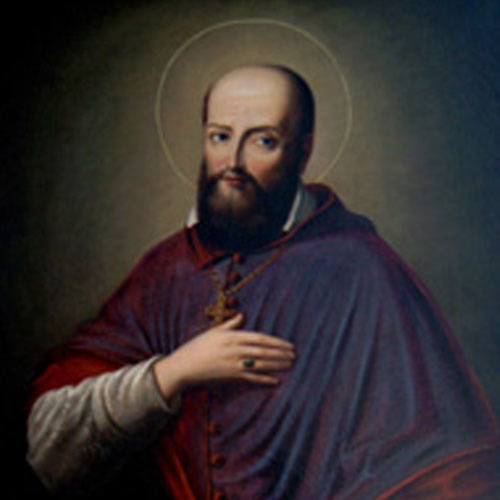
Saint Francis de Sales (1567-1622)
Feast day: January 24
Patron of the Catholic Press
Saint Francis de Sales was born in France. While he was in college, he discovered the “doctrine of predestination” and became convinced that he was doomed to hell! This caused him great distress and even despair. However, he prayed a Memorare, a famous prayer to Our Lady, before her statue. Gradually the Scriptures revealed to him that God was love, and this became the guiding light of his entire life.
Even though his father had sent him to law school, Francis de Sales wanted to be a priest. With great care and persuasion, Francis gradually won his father over. After ordination, Francis was sent to the Diocese of Geneva in Switzerland. This was a center of Calvinism, one of the Christian communities that emerged from the Protestant Reformation. Francis saw that converts to Calvinism were misunderstanding Catholic doctrine, and were rejecting the Catholic faith for that reason. Francis began to go door-to-door, to explain the Catholic faith to each family. But no one opened their doors! So he began writing little pamphlets about Catholicism. He distributed them by pushing them under the doors! These little pamphlets brought back many families to the Catholic faith.
When Francis became bishop of Geneva, he determined to be a “hands-on” bishop. He preached, he heard confessions, and he taught the faith to little children. His motto was: “A spoonful of honey attracts more flies than a barrelful of vinegar.” By this he meant that being gentle and kind, even with people who disagreed with him, was the best way to bring people back to Catholicism. Most people never knew that he had to work very hard to overcome his natural quick temper!
The writings of Francis de Sales were directed to lay people. He was convinced that they, too, could become saints. He wrote two books, An Introduction to the Devout Life and A Treatise on the Love of God. In addition, he wrote many pamphlets. His writings earned him the title of “Patron of the Catholic Press.”
When Francis met Saint Jane Frances de Chantal, he realized that they could work together for God and founded the Order of the Visitation of Holy Mary. They determined that their community would accept women that, because of physical limitations or other reasons, were not accepted into other orders or could not follow a very strict way of life. The Visitation nuns still exist today. Some conduct schools, while others are devoted exclusively to prayer.
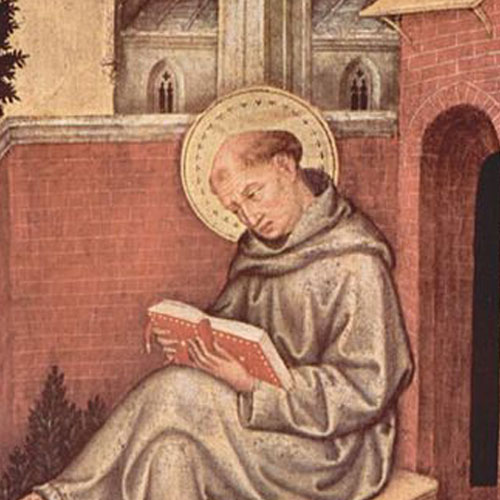
Saint Thomas Aquinas (1225-1274)
Feast day: January 28
Patron of theologians and students
When Thomas Aquinas was five years old, his parents gave him to the Benedictine monastery of Monte Cassino, in hopes that he would choose the Benedictine way of life. However, at the age of 14 he was sent to Naples for further study, and it was there that he met the philosophy of Aristotle. Four years later, he had decided to join the Dominicans, who were renowned as students and teachers of the Catholic faith.
His family was upset by this change of plans, and his brother kidnapped Thomas and kept him at home for over a year! However, eventually his family relented, and Thomas went to Paris to study under Saint Albert the Great. From then on, he became a professor, directed Dominican schools, lived at the Pope’s court in Rome, and became well-known for his teachings and writings.
Just because Thomas became a great scholar does not mean that he found school easy. Even though he was intellectually brilliant, he was large and slow and very rarely spoke up in class. The other students called him “the dumb ox.” His teacher, Saint Albert, used to say, “One of these days the bellow of this ox will be heard around the world.” He meant that Thomas Aquinas would be very influential in the Church because of his intelligence and his writings, and this turned out to be very true!
His greatest contribution was his book, “The Summa Theologiae.” This means “The Summary of Theology.” Thomas wanted to summarize the whole of theology (which means “study about God”) in one great treatise, based on what he had learned from the Aristotelian method of thinking, or the philosophy of Aristotle. Thomas believed that “reason,” the gift of God that helps us think, can help us to organize our thinking about God, and so he wrote his book based on reason and not only on Scripture or previous Church writings (but he included Scripture and previous writings in his arguments).
Unfortunately, he never finished his book! He stopped writing about a year before he died. When asked why, he would answer, “It is all straw.” By this Thomas meant that his words about God were so much less than his experiences of God and God’s love. However, it is said that Christ once appeared to him and said, “You have written well of me, Thomas.” It seems that God is pleased with our efforts, even if we think they are not perfect!
The influence of the Summa Theologiae is still felt today, as it is still taught in seminaries and universities throughout the world. Saint Thomas Aquinas, who used a pagan philosopher as the basis of his method of thinking, taught us not to be afraid to use our reasoning powers to think about and study God, because everything in human life comes from God and goes back to God.
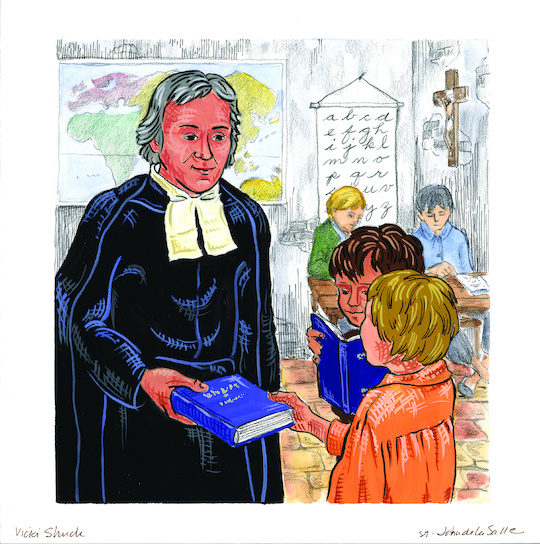
Saint John Baptist de La Salle (1651-1719)
Feast day: April 7/May 15
Saint John Baptist de La Salle was born in France. He belonged to an aristocratic family. He intended to become a priest, and he was looking for a comfortable and quiet life. But that is not what happened!
John did become a priest, but he was led, little by little, to help poor boys. How did an aristocratic priest get involved with poor boys who roamed the streets? He began by helping a friend! He was asked to help by one of his friends who was starting a school for these poor boys. In helping his friend, and seeing how much the boys needed education, John stepped into his life’s work.
At that time, education was very expensive, because it was given by tutors, one-on-one in homes. Not many people could afford a tutor. Parents who worked all day had no other choice but to leave their boys at home without supervision. John and his friend had this idea: If they grouped the boys together, according to age and ability, they could teach many boys at once. (At this time, boys and girls were educated separately and went to separate schools. There were communities of Sisters who taught poor girls.) Gradually, the grouping of children together became the normal way of educating children.
John knew that educating children required good teachers. So he opened his home to the men who taught in his school. In this way he could train the teachers to teach the children! They could talk about their problems and successes together when they met in his home. He then invited the men to live with him as a community. Eventually, a group of teachers joined John in making vows and becoming a religious community called the Brothers of the Christian Schools or the Lasallian Brothers.
The Christian Brothers opened schools all over the world. They and the men and women who teach in their schools follow John’s educational philosophy, which is called “Lasallian.” The core of John’s educational philosophy was this: Each one of us is made in the image and likeness of God. Each one of us has human dignity. The Lasallian educator helps to develop this dignity for the good of the student and for the good of society.
Saint John Baptist de La Salle has two feast days! The Church celebrates him on April 7, the day of his death, and he is also celebrated on May 15, which, in Lasallian institutions, is known as Founder’s Day.
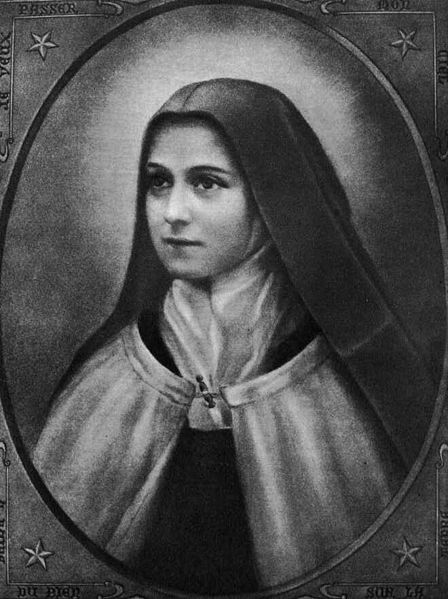
Saint Thérèse of Lisieux (1873-1897)
Feast day: October 1
Thérèse was born in France the youngest of five daughters. (All five daughters entered religious life. Four, including Thérèse, entered the local Carmelite monastery. The third daughter, Léonie, entered the Visitation nuns.) Her childhood was a happy one, surrounded by love and affection. But after her mother died, when Thérèse was about 4 and a half years old, things changed. Although her older sister Pauline was assigned to be her “little mother,” life became more difficult. At school, Thérèse was bullied by other girls who envied her good grades. When Thérèse was nine years old, her sister Pauline entered the Carmelite monastery. This was a second deep loss. Thérèse had always been sensitive, but now she began to have migraine headaches and terrible bouts of weeping. She would shake uncontrollably and could not speak. Today we might say she was having a panic attack. In one of these times, when she was physically exhausted, she looked up from her bed and saw the statue of the Blessed Mother that stood on a nearby dresser. The Blessed Mother was smiling at her. And Therese felt that she was healed.
Thérèse never forgot this grace, and it solidified her intention to enter the Carmelites earlier than usual, at age fifteen. She received her father’s permission, but the permission of the local bishop and the local Carmelite Mother Superior were different matters. Both thought she was too young. However, about that time, her father had arranged to take Thérèse and her older sister Céline on a pilgrimage to Rome, sponsored by the local diocese. Thérèse made a plan: “I will ask the Pope for permission!” When the time came, the pilgrims were instructed not to speak to the Pope! But Thérèse could not help herself. She asked the Pope for permission to enter Carmel at age fifteen. The Pope told her to do what the Superiors decided. But Therese persisted, saying, “Holy Father! If you say yes, everyone else will agree!” The Pope only said, “You will enter if it is God’s will.” And two Swiss Guards had to carry Thérèse away, weeping and crying! However, the local authorities, possibly because they admired her courage, agreed to let Thérèse enter the monatery. This “little flower,” as she called herself, had a spine of steel!
Thérèse’s outward life in Carmel was uneventful. She went to prayers and work with the other nuns and was also given charge of training the novices (the newest members of the community). While she was In Carmel, her father was taken to a mental hospital. This caused Thérèse much heartache. After her father died, her sister Céline also entered Carmel.
When Thérèse’s sister, Pauline, became Superior of the monastery, she asked Thérèse to write down the story of her life. And so she began, “The Story of a Soul,” her autobiography. It was the story not only of her outward life but her inner growth from childhood to what we recognize now as true sainthood. How did she do it? By following what she called her “little way”: doing little things for love.
Thérése believed and taught that this is all that God asks: to love, without asking anything in return. In her autobiography, time after time, she described how love shaped her life, even until, at the very end, she was tempted by a lack of faith. She offered up this trial for all those who did not believe in God. But love won! Her last words were, “My God, I love you!”
She was canonized as a saint in 1925 and declared a Doctor of the Church in 1997, one hundred years after her death.

